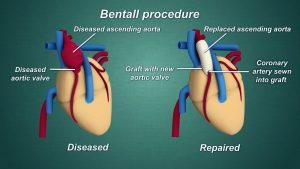Bentall procedure is a cardiac surgery operation involving composite graft replacement of the aortic valve, aortic root and ascending aorta, with re-implantation of the coronary arteries into the graft.
Bentall Procedure
Patient who have aneurysms in thoracic area and those who have assending Aorta or abonormal Aortic root are often recommended Bental procedure.Also, patients with Acute Aortic Dissection are recommended to have Bentall Procedure.
Aorta is the main artery that stems from the heart and divides into smaller arteries to carry oxygenated blood to all parts of the body. It can be divided into ascending aorta, aortic arc, descending thoracic aorta and abdominal aorta.
Bentall Procedure is known to be a gold standard in the treatment of patients seeking aortic root replacement. The Bentall procedure is a surgery carried out to correct aorta defects. The treatment involves replacing the aortic root and valve and re-implanting the coronary arteries. The latest and most common form of surgery is called a Bentall button.
When Bentall Procedure is required:
If you have problems with the aorta, the doctor may prescribe a Bentall procedure. Some of the most common issues which can occur include:
- Aortic regurgitation: when the aortic valve of the heart is not closed properly
- Marfan’s syndrome: a disease from birth that weakens the thickness of the aortic wall
- Aortic aneurysm: widening of the aorta
- Aortic dissection: when the aorta’s inner layer tears
The Bentall Procedure:
‘Button’ is the most common form of Bentall procedure. The heart is temporarily stopped when an incision is made in the chest, ensuring that no bleeding occurs. This helps the surgeons to properly perform the surgery. The part of the aorta that requires replacement is removed and are separated from the aortic wall by two coronary ‘buttons’ opposite each other. Using surgical needles and threads or sutures, a valve replacement tube is then fitted and connected to the aorta. As the procedure is completed, the surgeon will test the valve regularly to ensure whether it is secured properly so that blood is not flowing out. If the operation is all fine, the surgeon will complete the procedure.
















